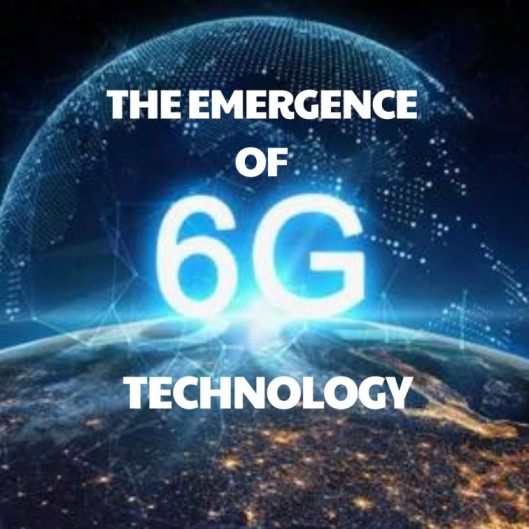The Emergence of 6G Technology

In the rapidly evolving landscape of technological advancements, the progression from one generation of wireless communication to the next has been a defining factor in shaping the way we connect, communicate, and interact with the world around us. As 5G continues to unfold its capabilities, discussions about the next phase, 6G technology, are already surfacing, promising an era of connectivity that surpasses the current standards in ways previously unimaginable.
The Evolutionary Journey:
Before delving into the prospects of 6G, it’s crucial to reflect on the trajectory of wireless communication. Each generational leap in mobile technology has brought significant enhancements in speed, reliability, and capabilities.
1G laid the foundation for mobile communication by introducing analog voice calls. 2G brought digital capabilities and facilitated text messaging, while 3G expanded services to include mobile internet. The advent of 4G revolutionized connectivity, enabling high-speed internet access, video streaming, and the rise of the app economy. 5G, the current pinnacle, brought ultra-fast speeds, lower latency, and the potential to power transformative technologies like autonomous vehicles and the Internet of Things (IoT).
The Vision of 6G:
6G technology is envisioned to transcend the boundaries of 5G, revolutionizing connectivity and spearheading a new era of innovation and possibilities. It is expected to deliver unprecedented speeds, ultra-low latency, and reliability that will not only transform communication but also redefine various industries.
One of the defining features of 6G is its potential to operate in the terahertz (THz) frequency band. This would enable data rates exponentially faster than what 5G can offer, reaching speeds in the order of terabits per second. The utilization of AI-driven networks, advanced signal processing, and novel antenna technologies will likely play pivotal roles in harnessing the potential of 6G.
Applications and Implications:
The emergence of 6G technology is poised to catalyze innovations across multiple sectors. From healthcare to transportation, smart cities, entertainment, and beyond, the impact is anticipated to be profound.
In healthcare, real-time remote surgeries facilitated by ultra-low latency connections could revolutionize patient care. Similarly, in autonomous vehicles, 6G’s responsiveness could be a game-changer, ensuring split-second decision-making for enhanced safety on roads.
The integration of 6G with augmented reality (AR) and virtual reality (VR) applications could transform how we perceive and interact with the digital world. Seamless, high-fidelity experiences could redefine entertainment, education, and remote work.
Challenges and Considerations:
Despite its promises, the journey towards 6G is rife with challenges and considerations. Technical hurdles, such as signal propagation at higher frequencies and the development of energy-efficient components, need to be addressed. Additionally, ensuring cybersecurity and addressing potential ethical concerns surrounding AI integration will be imperative.
Moreover, the deployment of 6G infrastructure demands significant investments and collaborations between governments, telecommunications companies, and technology innovators. Standards and regulatory frameworks must also be established to facilitate global adoption.
Global Initiatives and Research:
Several countries and organizations have already embarked on the path to 6G. Nations like China, the United States, South Korea, and the European Union are investing heavily in research and development to spearhead the technology. Collaborative efforts between academia, industry, and policymakers are fostering an ecosystem conducive to innovation in this domain.
Universities and research institutions worldwide are conducting extensive studies on 6G, exploring diverse aspects ranging from fundamental technologies to potential applications, ensuring a holistic approach towards its development.
The Road Ahead:
While 6G is still in its conceptual stages, its potential to redefine connectivity and pave the way for transformative technologies is undeniable. As 5G continues its global deployment, the anticipation and groundwork for 6G underscore the ever-evolving nature of technological progress.
In conclusion, the emergence of 6G technology represents a paradigm shift that promises to revolutionize connectivity, unlock new possibilities, and reshape the future of various industries. However, its realization will require concerted efforts, collaborations, and innovative solutions to overcome challenges and harness its full potential. As we navigate the complexities ahead, the journey towards 6G unfolds as an exciting frontier, promising a future where connectivity knows no bounds.
Tools of The Emergence of 6G Technology
The emergence of 6G technology represents a leap forward in wireless communication, promising unprecedented speeds, ultra-low latency, and revolutionary advancements. The development of 6G involves a multitude of tools and technologies that collectively contribute to shaping this next-generation network. Below are some of the key tools instrumental in the emergence and evolution of 6G technology:
Terahertz (THz) Communication:
- THz Band Spectrum: Utilizing frequencies in the terahertz range is one of the fundamental aspects of 6G. This spectrum provides significantly higher data transfer rates compared to the current spectrum used in 5G. Tools and devices capable of operating in these frequencies are crucial for the development of 6G networks.
Advanced Antenna Technologies:
- Metamaterials: These artificially structured materials have unique properties not found in nature. Metamaterial-based antennas can be designed to operate at higher frequencies, enabling improved performance in signal transmission and reception, vital for 6G communication systems.
- Beamforming and Massive MIMO: These technologies, already used in 5G, will see advancements in 6G networks. Beamforming focuses the signal in a specific direction, enhancing efficiency and reducing interference, while Massive Multiple Input Multiple Output (MIMO) enables the use of multiple antennas to increase data throughput.
AI-Driven Networks:
- Machine Learning and AI Algorithms: The integration of artificial intelligence and machine learning algorithms will play a pivotal role in 6G networks. These technologies will optimize network efficiency, manage traffic, predict user behavior, and adapt dynamically to changing conditions, ensuring enhanced performance and reliability.
Quantum Communication:
Quantum Encryption and Cryptography: With the potential to offer unparalleled security, quantum cryptography could safeguard sensitive data transmitted over 6G networks. Quantum key distribution (QKD) techniques ensure secure communication channels, resistant to hacking attempts using classical computing methods.
Integrated Communication Technologies:
- Wireless Optical Communication: Integrating optical communication within wireless networks could provide extremely high data rates and low latency. Tools focusing on seamless integration between wireless and optical communication systems will be crucial for 6G.
- Satellite Communication: Expanding the role of satellites in providing global connectivity will be pivotal for 6G networks. Tools that enhance satellite communication systems to deliver high-speed internet access across remote and urban areas will be essential.
Research and Development Tools:
- Simulation and Modeling Software: Advanced software tools aid in simulating and modeling various network architectures, protocols, and scenarios. These tools assist researchers and engineers in predicting network behavior and optimizing 6G designs before physical implementation.
- Testbeds and Prototyping Tools: Physical testbeds and prototyping tools are crucial for validating theoretical concepts, experimenting with new technologies, and refining 6G network components and functionalities before deployment.
- 5 IT REMOTE JOBS
Policy and Standardization:
International Collaboration and Standardization Bodies: Collaboration among countries, industry stakeholders, and standardization bodies such as the International Telecommunication Union (ITU) will establish global standards for 6G, ensuring interoperability and seamless integration across networks.
Conclusion:
The development and deployment of 6G technology encompass a wide array of tools, technologies, and collaborative efforts across multiple domains. The convergence of advanced communication tools, AI-driven systems, quantum communication, and robust research methodologies will shape the foundation of 6G networks. As these tools continue to evolve and integrate, they will collectively pave the way for a future of unparalleled connectivity and transformative technological possibilities.
DHAMAAD
Hadii aad intaan soo gartay waad guulesatay, waxaan ku rajayna inaa maqaalkan/ article kan wax ka faidi doontid illah idinkiis, waxii su’aalo ah qeybta comment no ku reeb ama tobic aad jaceshahay inaa kaso hadalno Insha allah. THANK YOU YOUR VISIT.





